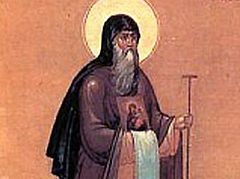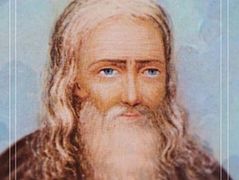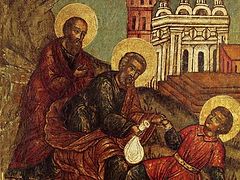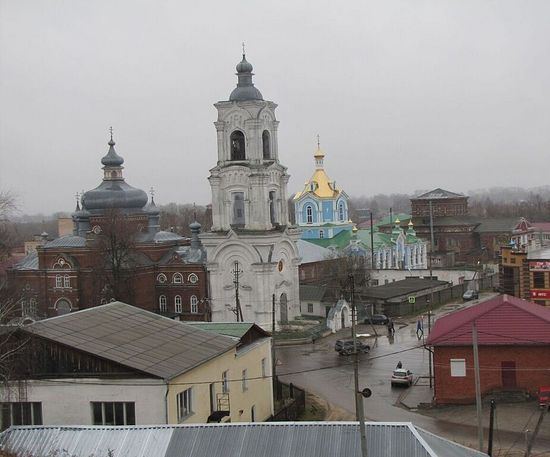 Kadom, view from Transfiguration Hill of the churches: Forefront, St. Dimitry of Rostov, next (blue), The All-Merciful Mother of God. The white building in the front was once the Holy Trinity Church. In the far background is the Church of the Burning Bush Mother of God, also partially destroyed. Photo: Daria Sofronova-Simeonoff
Kadom, view from Transfiguration Hill of the churches: Forefront, St. Dimitry of Rostov, next (blue), The All-Merciful Mother of God. The white building in the front was once the Holy Trinity Church. In the far background is the Church of the Burning Bush Mother of God, also partially destroyed. Photo: Daria Sofronova-Simeonoff
Although precise information about the early life of our holy father Herman of Alaska is scarce, and recent research has discovered new facts that were previously unknown to us, it has been established that St. Herman came from the town of Kadom, now in Ryazan Province. It is worth exploring the history and background of this region of Russia, which produced such extraordinarily pious offspring as St. Seraphim of Sarov, Elder Nazarius of Valaam, and our dear Fr. Herman of Alaska.
The first mention of Kadom in the Chronicles of Nikon, one of the main sources of information on Russia’s ancient history, is dated to the year 1209. But we know that the town existed much earlier than Russia’s Christian period, inhabited by Finno-Ugric peoples, the main one of which still exists today under the name Mordva. It is just that this town, located on the main tributary of the wide and long Oka River, appears during the thirteenth century as an eastern outpost of Russia, where chronicles were kept. Before that, it was first the home of a number of pagan tribes, vying with each other for control of the important river trade in the area. From the vast, dense forest along the Moksha River came pitch and wild honey, important commodities of the times. The river was also used to transport lumber, and it was (and still is) rich in fish. In those distant times, Kadom was at the center of a vast territory that included parts of modern Mordovia, and Nizhny Novgorod, Ryazan, Kazan, Azov and Voronezh provinces. Later Kadom’s status would wane as a regional center, and become subordinate to these different provinces in turn, ending up before the beginning of the twentieth century under the administration of Tambov—as was Kursk, where St. Seraphim was born. This would explain why some Lives place St. Herman’s birthplace as Voronezh—Kadom was once in Voronezh province! It is also why St. Herman and St. Seraphim can be considered as having come from the same native land. Incidentally, they were born just three years apart.
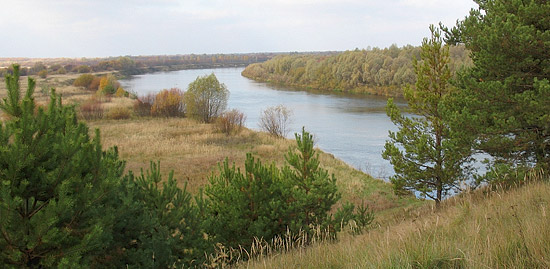 The Moksha River. Photo: Anton Pospelov
The Moksha River. Photo: Anton Pospelov
The name of the city is clearly not Slavic in origin. In fact, some historians claim that it comes from an Arabic word “kodim”, which means, “guard post”. This would make sense because of the town’s strategic position as a meeting point between the Slavs from the west, and the Tatars, Volga Bulgars, Polovsti, and Mordva in the east. Although much trade and cooperation between these people took place here, the meetings were not always peaceful. Particularly in pre-Christian Russia, Slavic tribes such as the Vyatichi and Krivichi would raid the Mordovian and Volga Bulgar lands, pushing eastward. Later, after the Christianization of Rus', the Tatars pushed westward against the Slavs. There are historical records dating the Mongol Tatar Batei as conquering these lands in 1239. As a result, the local peoples came under Tatar rule and were conscripted into their armies, which wrought such destruction in Rus’ as far away as Smolensk, Kiev, and Galicia.
But by that time there were Orthodox Christian Russians living in settlements in that region, and the Christian religion began little by little to spread to the local pagan tribes and Tatars. For example: The thirteenth century saw the settlement of nomadic Tatars into the fertile pastures along the Moksha River. In 1298, one of the Tatar princes, Bakhaet Shirinsky, seized the territory along the Tsne River and lower Moksha and founded his own principality. But under the strong influence of a neighboring Russian settlement, the prince’s son, Beklemesh, was baptized with the name Michael. He built a church there in a settlement called Andrew’s town, and baptized all his family and subjects in it. No one knows for certain where that town was located, since nothing is left of it. But some historians place it in the very town of Kadom, on Transfiguration Hill. Others consider that it was located just outside town, in the modern-day village of Preobrazhenka (also named after the Transfiguration). In any case, this is an early example of an asian invader’s conversion to the religion of the Russians, and their peaceful life together. It also marks the beginning of the transfiguration of people from pagan darkness to the light of Christ in the land of Kadom.
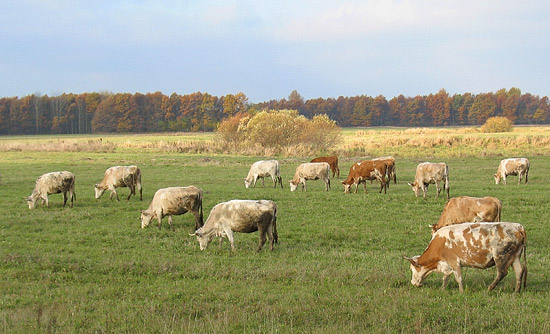 Kadom pastures. Photo: Anton Pospelov
Kadom pastures. Photo: Anton Pospelov
In 1382, Prince Dimitry Donskoy, a Russian saint who is famous for leading the battle of Kulikovo against the Mongol Tatars, purchased this region from the baptized Mordovian prince Alexander Ukovich, and signed an agreement with the Ryazan prince Oleg delineating the boundaries between Ryazan and Moscow provinces in the region—thus did Kadom come under Moscow’s administration. As many Tatar nobles joined the service of Moscow princes, they were granted their own lands in the region, and entirely inhabited the town of the newly formed city of Kasimov—named after the Tatar prince Kasim—located not far from Kadom. By that time, the Tatars had mostly become Muslims, but as a document signed by Ivan the Terrible states, they lived peacefully with the Christians, and in those settlements one could find mosques side by side with Orthodox churches.
As Muscovy gained increasing significance as the center of Russia, there was more interest in Moscow for converting the local peoples of its outposts to Orthodoxy. This culminated with the reign of Peter the Great. Again, this process can be seen in Kadom.
Under Patriarch Nikon, Archbishop Misail was appointed to Ryazan, and he was able to convert more than 5000 Mordovians of the Ryazan lands to Christianity. This righteous hierarch also did much to bring the Russians of that area back to a more pious way of life; the sorry state of many Russian parishes was a factor working against the spread of Christianity. The pagan tribes, who were resentful of Russians’ expansion, scandalized by their often less than exemplary behavior, and therefore rejected their religion, killed Misail with an arrow as he approached them with a plea for peace and their conversion. St. Misail is now commemorated as a hieromartyr of the Russian Church (April 9/12).
Another successful strategy for bringing the people of Kadom and surrounding regions into the Orthodox fold was the opening of monasteries.
The first monastery founded there was dedicated to the Holy Trinity, in Old Kadom, in around 1652. (Kadom was historically located at a distance of nine kilometers from today’s Kadom. For reasons not precisely known but presumably due to flooding, the people resettled in the mid sixteenth century to the Kadom of today). This monastery was committed to missionary work among the local people. In 1653, the St. Nicholas Cherneev Monastery was founded near the town of Shatsk, under the particular protection of the local Cossacks. (Near Shatsk is the town of Vysha, now famous for the monastery were St. Theophan the Recluse lived and wrote his well-known spiritual volumes.) In 1659, Sanaxar Monastery of the Nativity of the Mother of God was founded in Temnikov, Mordovia, sixty kilometers from Kadom; the first brothers there came from the Old Kadom Holy Trinity Monastery. And last but not least of the monasteries founded in that short period of time was the Holy Dormition Sarov Monastery, which dates its beginning to the year 1664, and is located 100 kilometers from Kadom.
Although the beneficial effect over time on the people of these regions is undeniable, the arrival of monks was not greeted warmly at first by the pagan Mordovians and Muslim Tatars. This was partly for purely material reasons: the monasteries were given lands that the local people wanted to use. But as people began to convert, they also met resistance from their own kinsmen. For example, the founder of the Cherneev monastery, Abbot Matthew, wrote to the Tsar: “The Mordovians do not allow me to use the forests or fell trees. And because I baptized many women and children, around twelve souls, and others of the Mordva desire baptism, the unbaptized Mordva cause us great trouble and threaten to defile the church and cast me and the brothers out into the steppe. And they steal our cattle and fowl, and they burned our monastery beehives.” In response to this letter, Tsar Alexei Mikhailovich Romanov granted the monastery more lands, and ordered the Shatsk administration to guard the monastery.
The largest push for baptism came under Tsar Peter the Great. He began the division of villages into the baptized and the non-baptized, and did not allow the non-baptized to live in the same villages as the baptized. The Christian villages were ordered to build churches and tear down mosques, while the Muslim Tatars villages were allowed mosques. This strategy turned out to be very effective, because the Christian villages now had their own churches, and the newly baptized were protected by law from the revenge of anti-Christian fanatics—and the law was enforced. Material rewards were given to those who accepted baptism. And although the number of people who accepted Christianity did not rise quickly or dramatically, a Christian culture was fostered within these villages that strengthened and endured, resulting in the formation of a pious Orthodox population. Over the course of about 200 years, Mordovians, Tatars, and Russians mixed together to the point of becoming something of a new local people, and Orthodox Christianity became the prevailing religion.
Because of its proximity to Sarov and Diveyevo, Kadom also came to be known as a part of the “Portion of the Mother of God”. St. Seraphim of Sarov visited Kadom many times, and tradition has it that the Mother of God appeared to him there, promising always to protect the town. St. Seraphim was known to proclaim that the Mother of God gave her blessing for a convent to be built there, which came to pass under St. Seraphim’s guidance.
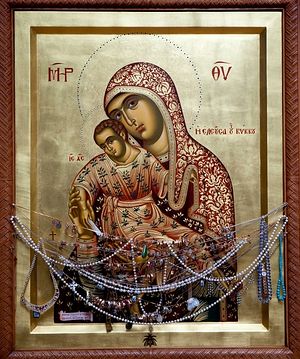 The Kikka "All-Merciful" icon of the Mother of God.
The Kikka "All-Merciful" icon of the Mother of God.
By the late eighteenth century, the people of Kadom were known for their particular piety and strict Christian life. Priest Ivan Kobyakov wrote in 1875, “The town of Kadom is a purely Christian town. All its citizens are pious and zealous for God’s churches.” It was said of them that they lived like monastics, in prayer and fasting. At that time, a group of pious girls decided to form a community, and with the support of the townspeople attached themselves to the Church of St. Dimitry of Rostov—the church that St. Herman would have attended as a child. In 1797, the diocese of Ryazan issued an order to found a women’s monastic community there. (By that time, St. Herman would have been 46 years old, and already in Alaska.) In 1868, the community was renamed the Kadom cenobitic monastery of the All-Merciful Icon of the Mother of God, and Ekaterina Barfolomeyevna Gorskaya was sent from a Ryazan convent to be the first Mother Superior. Ekaterina at first did not wish to be in charge of the monastery, but the clairvoyant elder Seraphim of Sarov told her to accept the responsibility for the sisters’ sake.
One of the sisters’ main obediences, which helped them support themselves, was weaving cloth and sewing. It is interesting to note that in Soviet times and even today, Kadom is known for its lace-making and sewing school.
The monastery kept a strict monastic rule based on that of Sarov Monastery. The sisters were under the spiritual care of the Sarov elders, Hieromonk Seraphim, abbot Nazarius (who later became the abbot of Valaam and St. Herman’s spiritual guide), and hieromonk Hilarion.
By the beginning of the twentieth century, the convent possessed agriculture dachas with large land holdings, and the sisters numbered 365. It had four churches—three in the convent itself, and one on the Nikita dacha.
But the whirlwind of destruction that gained mortal force in the early twentieth century under the Communists did not spare the pious town of Kadom. On the feast of Pentecost in 1920, horsemen rode into the town with shrieks and whips, and thus began the intentional destruction of the town’s pride and joy—the Convent of the All-Merciful Mother of God. 400 people including priests, nuns, and orphans were kicked out of the monastery and the property was either confiscated by the state or torn down. A rare collection of icons, books, and archives perished. The buildings left standing were repurposed as storage or schools. The sisters moved into tiny houses around the town, and continued their prayers and vigils.
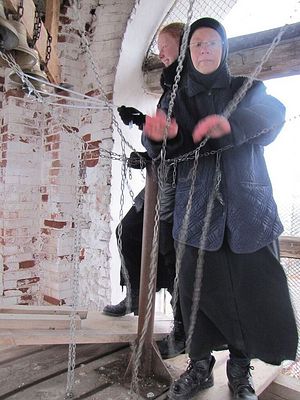 Photo: Daria Sofronova-Simeonoff Now monastic life in the convent is being slowly renewed—it was re-opened in 1997, at the initiative of Elatma native, Archpriest Anatoly Kultinov, now Archimandrite Athanasius. The Church of St. Dimitry of Rostov was not destroyed and is now used solely as a parish church, but the convent was given back the Church of the All-Merciful Icon of the Mother of God, with its two side-altars—to St. of Radonezh and St. Seraphim of Sarov. Still being used as a town administration building is the Church of the Burning Bush Icon of the Mother of God, located next to the main church. The sisterhood is small, and much work needs to be done.
Photo: Daria Sofronova-Simeonoff Now monastic life in the convent is being slowly renewed—it was re-opened in 1997, at the initiative of Elatma native, Archpriest Anatoly Kultinov, now Archimandrite Athanasius. The Church of St. Dimitry of Rostov was not destroyed and is now used solely as a parish church, but the convent was given back the Church of the All-Merciful Icon of the Mother of God, with its two side-altars—to St. of Radonezh and St. Seraphim of Sarov. Still being used as a town administration building is the Church of the Burning Bush Icon of the Mother of God, located next to the main church. The sisterhood is small, and much work needs to be done.
Another remarkable holy site near Kadom is the holy spring called “Panika”—a popular place of pilgrimage. The spring was known for its healing qualities even before it became the site of a monastery. Centuries ago, the then densely-wooded area became a place of refuge for desert dwelling monks. The spring was under a large oak tree called the “tree of the martyrs”, and nearby was a chapel dedicated to St. John the Forerunner and a rock on which could be seen red spots that resembled spilled blood, for which it was called the “martyrs’ rock”. Even today there are old people in the region who remember that the monks would gather for vigil at night in the chapel, then depart to their individual places of reclusion in the morning. Soon pilgrims were drawn by the thousands to this holy place, and a church was built to St. John the Forerunner, where local clergy would serve the Liturgy on Sundays and feast days.
When the communists came to power, they attacked this hermitage with especial virulence. All the monks were murdered on site, thus justifying the prophetic name of the tree and the rock of the martyrs. Now the site looks very different from the old folks’ description—many trees have been cut down, and the church is gone. But many pilgrims still visit the healing spring, despite the difficulty of getting there on a very rough dirt road. There have been many healings recorded by people who immersed themselves in the spring with faith.
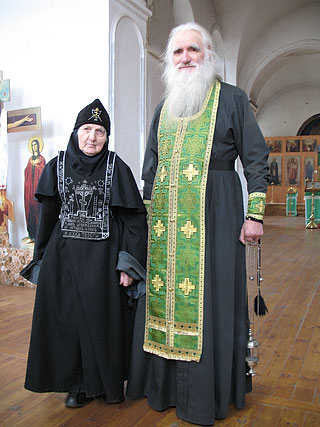 Archimandrite Athanasius and his mother, a schemanun at the convent.
Archimandrite Athanasius and his mother, a schemanun at the convent.
The land of Kadom had grown over the centuries to a great tree of Orthodox piety, producing such saints as our beloved Fr. Herman of Alaska—veritable pillars from earth to heaven. And although the tree was damaged and cut, the people of this land feel the strength of the great root. “This land gives us strength,” Christians now say there, “and we inherited the faith of our forefathers.” Unfortunately, modernity is perhaps taking more of a toll on peoples’ faith than atheist repressions—television, idleness, and computer games captivate young people’s souls. But Fr. Athanasius, who still continues his labors of guiding the sisters of the Kadom convent and receiving pilgrims, has great hopes for this region. “I think that if the convent comes back to life, first of all in the spiritual sense, then Kadom will come back to life. Now the Mother of God is clearly preparing this place for important work. I look into my soul, mind, and heart, and see that Orthodox people should gather here from Russia and from other countries, and glorify Christ together.”
Perhaps the new church dedicated to St. Herman of Alaska now being built by Fr. Athanasius’s son, Fr. Dimitry, on Kadom’s Transfiguration hill, could just be that focal point of praise.

